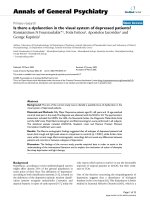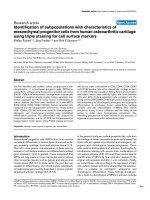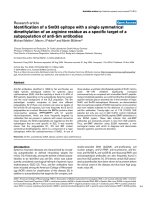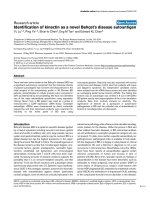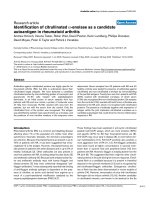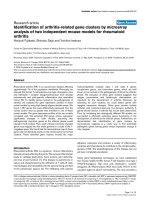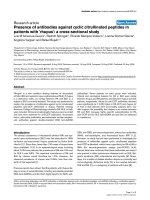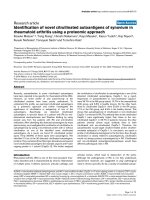Báo cáo y học: "Identification of a truncated form of methionine sulfoxide reductase a expressed in mouse embryonic stem cells" pps
Bạn đang xem bản rút gọn của tài liệu. Xem và tải ngay bản đầy đủ của tài liệu tại đây (1.96 MB, 10 trang )
RESEA R C H Open Access
Identification of a truncated form of methionine
sulfoxide reductase a expressed in mouse
embryonic stem cells
Pingping Jia
1
, Chi Zhang
2
, Yuanyuan Jia
1
, Keith A Webster
2
, Xupei Huang
3
, Andrei A Kochegarov
5
,
Sharon L Lemanski
4
and Larry F Lemanski
4,5*
Abstract
Background: Methionine Sulfoxide Reductase A (MsrA), an enzyme in the Msr gene family, is important in the
cellular anti-oxidative stress defense mechanism. It acts by reducing the oxidized methionine sulfoxide in proteins
back to sulfide and by reducing the cellular level of reactive oxygen species. MsrA, the only enzyme in the Msr
gene fami ly that can reduce the S-form epimers of methionine sulfoxide, has been located in different cellular
compartments including mitochondria, cytosol and nuclei of various cell lines.
Methods: In the present study, we have isolated a truncated form of the MsrA transcript from cultured mouse
embryonic stem cells and performed eGFP fusion protein expression, confocal micro scopy and real time RT-PCR
studies.
Results: Results show a different expression response of this truncated transcript to oxygen deprivation and
reoxygenation treatments in stem cells, compared to the longer full length form. In addition, a different subcellular
localization pattern was noted with most of the eGFP fusion protein detected in the cytosol.
Conclusion: One possibility for the existence of a truncated form of the MsrA transcripts could be that with a
smaller protein size, yet retaining a GCWFG action site, this protein might have easier access to oxidize methionine
residues on proteins than the longer form of the MsrA protein, thus having an evolutionary selection advantage.
This research opens the door for further study on the role and function of the truncated MsrA embryonic mouse
stem cells.
Background
Free radical damage of cell ular components, including
proteins, has lo ng been recognized in physiological
aging and disease conditions. One of the cellular defense
mechanisms to reduce the oxidized residues in proteins,
and thus restore their functions as well as reduce oxida-
tive stress, relies on the methionine sulfoxide reductase
(msr) family genes, of which three MsrB genes (MsrB1,
B2 and B3), have been identified in mammals [1-7].
Only one MsA gene has been found in mammals [1-7].
While both MsrA and MsrBs conduct the redox reac-
tions with a similar chemical reaction mechanism,
MsrBs c an convert me thionine- R-oxide (R-MetO) back
to methionine while MsrA reduces methionine-S-oxide
(S-MetO), respectively[4,8]. MsrBs locali ze at diff erent
cellular compartments: 1. MsrB1 is a cytosolic and
nuclear protein; and 2. MsrB2 i s targeted to mitochon-
dria. Human MsrB3 gives rise to two forms generated
by alternative first exon splicing, which are targeted to
the endoplasmic reticulum (ER) and mitochondria [4] of
the cell.
AlthoughonlyasingleMsrAgeneisfoundinmam-
mals, the corresponding protein is found to localize in
multiple cellular compartments [ 9]. Further studies on
human MsrA ge ne structures have identified two dis-
tinct putative promoters that generate three transcripts.
The main MSRA transcr ipt (MsrA1) was translated into
the longest protein which localizes in mitochondria.
* Correspondence:
4
Department of Anatomy and Cell Biology and The Cardiovascular Research
Center, School of Medicine, Temple University, Philadelphia, Pennsylvania
19140, USA
Full list of author information is available at the end of the article
Jia et al. Journal of Biomedical Science 2011, 18:46
/>© 2011 Jia et al; license e BioMed Centra l Ltd. This is an Open Access article distributed under the terms of the Creative Commons
Attribu tion License ( .0), which permits unrestricted use, distribution, and repro duction in
any medium, provided the original work is properly cited.
MsrA2 and 3 originate from a second promoter and tar-
get the cytosol and nuclei [ 10,11]. More recent studies
from rat smooth m uscle cells reve aled two novel splice
forms: MsrA2a and MsrA2b [12]. The alternative spli-
cing event occurred at the level of the second exon with
MsrA 2a coding a functional isoform. It seems that both
alternative promoter s and alternative splicing contribu te
to the variety of MsrA isoforms that are responsible for
methionine sulfoxide reduction in different cellular
compartments.
To date, most of the studies on MsrA isoforms are
focused on the 5’ terminus where a mit ochondrial signal
peptide is alternatively presented in different isoforms
dictating whether or not the protein products a re loca-
lized in the mitochondria [10,12,13 ]. Although there is
evidence that transcripts of MsrA from alternative spli-
cings at the 3’ end of the MsrA gene are present in the
mammalian EST database, due to the concern that these
transcripts might not translate into enzymatically active
protein products, no detailed studies to date have been
reported on these transcripts [13].
We have consistently found a MsrA transcript from
alternative splicing at the 3’ end, skipping exon 5, thus
producing a shorter isoform with a presumably trun-
cated protein product containing the conserved catalytic
active site in cultured mouse embryonic stem cells. Due
to the importance of anti-oxidative stress mechanisms
in stem cells, we have performed studies on this isoform
in its expression pattern in normal culture c onditions
and its response to oxygen depletion/reoxygenation con-
ditions in mouse embryonic stem cells.
Methods
Mouse embryonic stem cell culture
The mouse embryonic stem (MES) cells (CCE-24) were
routinely grown on 0.1% gelatin-coated dishes in Dubec-
co’s Modified Eagle’ smedium(DMEM)containing15%
heat-inactivated fetal bovine serum (catalog # 10100,
Invitrogen, Carlsbad, CA), 10 ng/ml human leukemia
inhibitory factor (LIF) (LIF2010, Millipore, Billerica,
MA), and monothioglycerol (Sigma, St. Louis, Mo.) at
4.5 × 10-4 M [14]. Cells were grown on tissue culture
plates coated with 0.1% gelatin (Sigma, St. Louis, WA)
and routinely split every two days at 1:4 to 1:10 and
immunostained for stem cell specific markers SSEA-1
(Mab4301) and SSEA-4 (Mab4304, Millipore, Billerica,
MA) to ensure no differentiation. Only cells within the
20th passage were used.
Anoxia/reoxygenation treatment
Theanoxictreatmentofmouseembryonicstemcells
was performed by incubating the cells in an anaerobic
chamber ( Sheldon Manufacturing Inc., Cornelius, OR)
supplied with 90% nitrogen gas, 5% hydrogen gas and
5% carbon dioxide at 37°C. Cells were removed after
selected periods of treatment and incubated again in a
regular cell culture incubator at 37°C for designated
times.
Cloning of t he truncated form of MsrA cDNA and
construction of MsrA-truncated-eGFP fusion expression
plasmid followed methods routine in our laboratory and
recently published [15].
MsrA cDNA was amplified from the total RNA
extracted from cultured embryonic stem cells using the
primer pairs of: MsrA-for: 5’ -cctggctgcggaggtggagaaac
and MsrA-rev: 5’ -atggccatcgggcaggaa actcc. The 744bp
DNA band was gel purified and ligated into pGEM-T
easy vector (Promega, WI). After se quencing to confirm
gene sequences and rule out mutations, PCR was per-
formed again using the following primer pairs to amplify
the truncated form of MsrA and introduce a BamHI
cutting site at the 3’ end (MsrA-for: 5’-cctggctgcggaggtg-
gagaaac and MsrA-BamHI-rev: 5’ -tggggccaaggatccgcttt-
gaa agaacc). The amplicons were gel purified and ligated
into pEGFP-C vectors (Invitrogen, CA) to construct the
truncated MsrA-eGFP expression plasmid. The trun-
cated MsrA cDNA in the final plasmid was sequenced
again to confirm the open reading frame.
Confocal microscopy
After the MsrA-truncated-eGFP fusion expression plas-
mid was transfected into cells for three to five days and
after confirmation of the GFP fluorescence signal by
epi-fluo resce nt microscopy, 500 nM Mitotracker (Mole-
cular Probe (Invitrogen), Carlsbad, CA) was diluted with
complete culture medium and added to the cells. The
cells were incubated for 30 minutes and checked under
epi-fluorescence microscopy to confirm that they were
well stained by the dye. The Mitotracker medium was
discarded. Cells were washed with PBS and fixed in 1%
Formaldhyde in PBS for 15 minutes at room tempera-
ture. Cells were r insed with PBS twice and incubated in
a 1/10000 dilution solution of DAPI (10 mg/ml) in PBS
for 15-20 minutes. Cells were then mounted in the
mounting solution Pro-Long (Molecular Probe, Carls-
bad, CA), air-dried for 2 days in the dark, and coverslips
were sealed to the slides with fing ernail polish. Confocal
microscopy w as carried out using a Carl Zeiss confocal
microscope at the University of Miami Diabetes
Research Institute. Five micron Z-series were scanned
for each sample.
Real time RT-PCR
Real time RT-PCR experiments were performed accord-
ing to our published procedures [16,17]. The primer
sequences used in these studies were as follows:
MsrA-long form-for: 5’-TCTGGGTCTTGAAAGG
AGTGTA;
Jia et al. Journal of Biomedical Science 2011, 18:46
/>Page 2 of 10
MsrA-long-form-rev: 5’ -AGGTATTGCTGGTGG-
TAGTCTTC; Amplicon size: 395bp.
MsrA-truncated-for: 5’ -
CGACCCGACCCAAGGTTCTTTCA;
MsrA-truncated-rev: 5’ -GCCATCGGGCAGGAA
ACTCCAG; Amplicon size:168bp
b-actin-for: 5’-CCACTGCCGCATCCTCTTCCTC;
b-actin-for: 5’-CAGCAATGCCTGGGTACATGGTG;
Amplicon size: 249bp.
Results and Discussion
Evidence of the existence of a smaller form of MsrA in
mouse embryonic stem cells
From our previous studies on MsrA[15], we have con-
sistently found that there is a noticeable protein band
with a molecular weight (MW) of about 16 kD from
Western blotting experiments using anti -MsrA antibody
(Figure 1A, thick arrow). The hybridization signal is
very low, usually becoming evident on the X-ray film
with the longer form of MsrA bands overexpo sed
(Figure 1A, thin arrow). There are also protein b ands
with molecular weights of ~46~48 kD indicating homo-
dimers from MsrA long form proteins (Figure 1A, arrow
head), even with protein samples thoroughly treated by
reducing agents before SDS-PAGE, consistent with find-
ings from other laboratories [10]. On the film, there is
also a band with a molecular weight of 39 kD, possibly
hetero-dimers formed by a long form protein of MsrA
(MW: 23 kD) and a smaller form of MsrA protein (MW
16 kD) (Figure 1A, * ). In addition, a f aint band with a
molecular weight of 32 kD, possibly the homo-dimers
formed by two molecules of the smaller form of MsrA
proteins is observable (Figure 1A, ** ). The 32kD and
39kD bands cannot readily be explained by the dimeri-
zation from cytosol isoforms of MsrA which are 19-
20kD in size [10,13]. To confirm the existence of this
smaller form of protein, we have carried out RT-PCR
using total RNA extracted from mouse embryonic stem
cell s to amplify the full cDNA. The forward and reverse
primers were designed based on the 5’-UTR and 3’-UTR
of the known full length MsrA cDNA respectively (Gen-
ebank#: NM_026322.3 ). RT-PCR products were loaded
onto a 1% agarose gel for electro phoresis; clearly two
bands are visible on the gel with the smaller on e (Figure
1B, thick arrow) showing onlyabout1/20oftheinten-
sity and being about 100bp smaller than the la rger band
(Figure 1B, thin arrow).
Cloning of the cDNA of the truncated form of MsrA
The RT-PCR products of the smaller band were recov-
ered from agarose gels and ligated to the pGEM-T-easy
vector (Invitrogen, CA). After DNA sequencing, the
smaller form sequence was aligned and compared to
the full length cDNA from the Genebank. A deletion of
the fifth exon (113bp) was found in the smaller form
which ends up with a frame shift in the sixth exon
directly attached to the fourth that generated a new
prem ature stop codon (Figure 2A , 2B). The total length
of the truncated form protein is 148 amino acids, com-
pared to the full length protein which has 233 amino
acids, both containing a mitochondrial signal peptide at
the N-terminus (Figure 2C). The truncated form still
retains the GCFWG functional motif (catalytic active
site) but contains neither of the two cysteines at the c-
terminus (Figure 2B). Due to the functional importance
of the two c-t ermi nal cysteines in the redox reaction, it
is reasonable to believe that the enzyme activity for
methionine sulfoxide reduction will decrease dramati-
cally, which needs to be confirmed by the studies on
purified proteins translated from this truncated tem-
plate. It is interesting that we have also identifi ed a vir-
tually identical mouse EST sequence from a kidney
cDNA library in Genbank (Genbank ID: BG970953.1)
with the same intron splicing pattern as the truncated
form of MsrA cloned from embryonic stem cells, indi-
cating this isofor m might not be stem cell specific. The
comparison between the EST sequence and truncated
MsrA is illustrated in Figure 3. Except for missing ten
nucleotides at the end of the third exon (boxes in
Figure 3 and Figure 2A), the EST sequence showed
100% identity to the truncated cDNA from the 113th
Figure 1 Western blotting experiment using MsrA antibody
reveals a smaller MsrA protein in cultured mouse embryonic
stem cells. A. Thick arrow: the smaller form (~16 kD); thin arrow:
the large form (~23kD); arrowhead: possible dimers from the long
form MsrA proteins; *: possible heterodimers from a large form and
a shorter form protein; **: possible homodimers from two shorter
form proteins. B. Agarose gel electrophoresis of the amplified cDNA
of MsrA showing a smaller band. PCR bands: long form: 857bp (thin
arrow); short form: 744bp (thick arrow).
Jia et al. Journal of Biomedical Science 2011, 18:46
/>Page 3 of 10
Figure 2 The cDNA sequence of the truncated form of MsrA with the predicted open reading frame. Thin lines indicate exon- exon
junctions. A. The thick line points to the junction of exon 4 and 6 skipping exon 5 in the truncated form but is included in the long form of
MsrA. Shaded sequences are the two primers used to amplify the whole cDNA. Sequences underlined show the primer pairs for real time PCR
to specifically amplify the truncated form with the forward primer designed on the junction of exon 4 and 6. B. The truncated form contains 148
amino acids with a mitochondrial signal peptide at the N-terminus and a GCFWG motif but no c-terminal cysteines. C. Schematic illustration of
exon compositions for the long form and truncated MsrA cDNA. Arrows point to the translation stop sites.
Jia et al. Journal of Biomedical Science 2011, 18:46
/>Page 4 of 10
nucleotide (at the 5’ UTR) to the very end of truncated
form of the Msr cDNA.
Confocal microscopy reveals different subcellular
localizations for the truncated MsrA protein compared to
the full length using eGFP fusion constructs
The long form of the MsrA full length protein conju-
gated with the eGFP tag has been studied previously in
our laboratory and was found to be predominantly
mitochondria located with detectable signals from the
cytosol [15]. Current studies confirm the same finding
with the MsrA long f orm-eGFP fluorescence signals
(green, figure 4B); t he mitochondria stained by Mito-
Tracker (red, figure 4A) mostly overlap each other and
show an orange color (figure 4G). However, the MsrA
truncated form-eGFP fusion protein shows more non-
specific localization mostly in the cytosol although green
fluorescent sig nals in mitochondria can be det ected
(Figure 4D, E, F and 4H ). To further confirm this obser-
vation, we have generated Figure 5, a combination of
three single slices of confocal scan, each from a different
view angle, top view (A), upper-side view (B) and right-
side view (C) on a stem cell colony with the truncated-
MsrA-eGFP transfection. This permits a much clearer
three dimensional configuration of the subcellular locali-
zation of the truncated protein than a single view. On
the fo cal point of the scans (crosspoint of the horizontal
green line and the vertical pink line), clearly the green
fluorescent signal is excluded from nuclei stained by
DAPI. Most of the green signals are not overlapping
with the red mitochondria in all three view angles
(arrowhead, Figure 5C) a lthough there are some detect-
able colocalizations evident (arrow, Figure 5B).
Recent studies from Lee et al., [10] and Pascual et al.,
[11] have demonstrated the existence of two alternative
promoters for the MsrA gene that encodes different
Figure 3 Comparison between truncated form of MsrA cDNA (Trunc) and a mouse EST sequence from a kidney cDNA library in
Genbank (EST). The EST sequence lacks ten nucleotides comparing with the truncated cDNA which is shown in the box. The same area is also
shown in a box in Figure 2A, which is located at the very end of the third exon.
Jia et al. Journal of Biomedical Science 2011, 18:46
/>Page 5 of 10
Figure 4 Confocal microscopy on the long f orm MsrA-eGFP (A,B, C,G) and truncated MsrA-eGFP (D,E,F,H) transfected mouse
embryonic stem cells. A,D: mitochondria stained by propidium iodide; B,E: green fluorescence showing GFP tags; C,F: nuclei stained with DAPI;
G: overlapped image from A, B and C, but with higher magnification; H: image overlapped from D, E and F; Bars: 10 μm.
Jia et al. Journal of Biomedical Science 2011, 18:46
/>Page 6 of 10
isoforms of MsrA proteins that locate in mitochondria
or cytosol/nuclei due to the presence or absence of a N-
terminal mitochondrial signal peptide. However, studies
from Kim and Gladyshev [13], using GFP fusion techni-
ques and deletion mutagenesis have revealed other
important functional domains in the MsrA peptide
sequence, including sequences close to the c-terminus,
that may also direct the specific locations of the protein
in subcellular compartments. In addition, localization of
the mitochondrial form of MsrA in the cytosol and
nuclei is also noted by Kim and Gladyshev [18] in MsrA
overexpression studies. Although syntheses of different
isoforms with or without N-terminal signal peptide
might be the optimal way for the cells to direct protein
sorting, it definitely should not be ignored that the same
isoformmightstillbeabletolocatetomultiplecellular
compartments. While we do not rule out the possibility
that the altered localization pattern for the truncated
protein compared to the long form is due to GFP fusion
interference, it is most unlikely considering the fact the
same method has been used successfully to reveal sub-
cellular localization of MsrA in our cell lines [15]. Our
studies on the truncated MsrA-eGFP fusion protein sug-
gest a necessary domain at the c-terminal sequence for
permanently docking of the protein on mitochondria. In
addition to the mitochondria sig nal peptide, there might
exist another essential domain at the c-terminal end of
the full length protein, without which, the truncated
proteins, are able to be sorted to the mitochondria but
will eventually leak out back into the cytosol. In the
deletion mutagenesis studies of Kim and Gladyshev [18],
the deletion is limited only to the very end of the N-
Figure 5 Confocal microscopy of a single colony of mouse embryonic stem cells. A: top view of a single slice of scanning showing most
eGFP signals are not overlapping with mitochondria or nuclei. B: single slice scanning from upper-side view; J-2: single slice scanning from right-
side view. The arrow in B indicates some overlapping signal of truncated Msr-eGFP and mitochondria. The arrowhead in C points to the area
where the truncated Msr-eGFP signals are not overlapping with mitochondria, but mainly in cytosol. The crosspoint of the horizontal green line
and vertical red line points to the area we are observing. The blue lines in B and C show the current slice position for this confocal scanning.
Jia et al. Journal of Biomedical Science 2011, 18:46
/>Page 7 of 10
terminus or very middle, not totally overlapping the
portion omitted in this truncated form which could har-
bor more functional domain units [18].
Real time RT-PCR shows a different response of mRNA
expression levels for the trunctated form compared to
the full length MsrA
Our studies using real time RT-PCR on the long form
MsrA expression responses to oxygen deprivation and
reoxygenation show that the expression levels decrease
along with longer anoxia/reoxygenation treatment com-
binations (Figure 6B). However, the same type of study
on the truncated MsrA transcripts (Figure 6A) shows
different responses compared to the long form, except
that at 4 hours of anoxia treatment, both truncated
form and the long form show decreases at the mRNA
level which is considered as a general initial response of
stem c ells to oxygen deprivation as it is observed in all
Msr genes as well as in o ther genes such as ma trix
metalloproteinases 2 and 9 (MMP2 and MMP9) [15].
The mRNA of the truncated form decrease s most dra-
matically when a short reoxygenation (4 hours) was
given after a long period of anoxia (12 hours) (12+4,
Figure 6A). At this point, the level of reactive oxygen
species (ROS) in the cells are expected to rise substan-
tially. Expression level partially recovers after 12 hours
Figure 6 Real time RT-PCR studies on the expression responses at the mRNA levels for the truncated MsrA (A) and long form MsrA (B)
after specific hours of anoxia followed by specific hours of reoxygenation treatments. For example, 12+4 shows 12 hours of anoxia and 4
hours of reoxygenation afterwards. *: P < 0.05 when comparing 12+4 to 12+0 and 12+12.
Jia et al. Journal of Biomedical Science 2011, 18:46
/>Page 8 of 10
of reoxygenation following the 12 hours of anoxia treat-
ment (12+12), to the same level as 12 hours of reoxy-
genation following 8 hours of anoxia (8+12), at which
point the level of reactive oxygen species might have
decreased compared to the point of 12+4. Our results
indicate that the truncated form of the MsrA transcript
might be responsive to the cellular level of ROS. Com-
paring the expression levels at 12+4 and 12+12 time
points for the long form and truncated MsrA mRNA,
we could see that the truncated form is more sensitive
to oxidative stress level changes.
Conclusions
In summary, a c-terminal truncated form of MsrA has
been cloned from mouse embryonic stem cells due to the
skipping of exon 5 and subsequent frame shift in exon 6,
generating a premature stop codon. The truncated pro-
tein shows a different subcellular localization and pattern
of expression response to anoxia/reoxygenation treat-
ment on the stem cells. Further study on the enzymatic
activity of this peptide is needed to consider it as a func-
tional isoform. One possibility for the necessity of having
such a truncated form could be that with a smaller pro-
tein size and retained GCWFG active site, this protein
might have easier access to the oxidized methionine resi-
dues on proteins with structure hindering the access f or
the long form protein, thus having an advantage to be
evolutionarily selected and maintained. Since the trun-
cated protein itself does not contain the c-terminal
cysteines, whether the final relieving of the oxidation step
needs the long form MsrA is unknown, although we did
observe that heterodimers formed between long form
and truncated proteins in Western blotting experiments.
Acknowledgements
The study was funded by NIH grants HL-58435 and HL-61246 and an
American Heart Association Grant to LFL, an American Heart Association
grant to X.H., an NIH grant to K.A.W. and a NIH Summer Research
Scholarship to C.Z. The content of this publication is solely the responsibility
of the authors and does not necessarily represent the official views of the
National Heart, lung and Blood Institute of Health. We are grateful to Mrs.
Amy Patrick for outstanding secretarial and administrative assistance in the
preparation and submission of this manuscript.
Author details
1
Project to Cure Paralysis, University of Miami Miller School of Medicine,
Miami, FL 33136, USA.
2
Department of Molecular and Cellular Pharmacology,
University of Miami, Miller School of Medicine, Miami, FL 33431, USA.
3
Department of Biomedical Science, Florida Atlantic University; Boca Raton,
FL 33101, USA.
4
Department of Anatomy and Cell Biology and The
Cardiovascular Research Center, School of Medicine, Temple University,
Philadelphia, Pennsylvania 19140, USA.
5
Department of Biological and
Environmental Sciences, Texas A&M University-Commerce, Commerce, TX
75429-3011, USA.
Authors’ contributions
PJ was involved in the conception and design, provision of study materials,
collection and assembly of data, data analysis and interpretatio n and
manuscript writing for this paper. CZ participated in the conception and
design, collection and assembly of data, data analysis and interpretation,
manuscript writing and final approval of manuscript for publication. YJ -
Provided study materials, collection of data, data analysis and interpretation
and manuscript writing for the paper. KW was involved in the conception
and design, financial support, administrative support, provision of study
materials, collection and assembly of data, data analysis and interpretation,
manuscript writing and final approval of the manuscript. XH Participated in
the collection and assembly of data, data analysis and interpretation,
manuscript writing and final approval of the manuscript. AK was involved in
manuscript writing and data analysis. SL was involved in the conception and
design, administrative support, data analysis and interpretation, manuscript
writing and final approval of the manuscript. LL Oversaw the research
including the conception and design, financial support, administrative
support, provision of study materials, collection and assembly of data, data
analysis and interpretation, manuscript writing, final approval of manuscript
as well as serves as the Principal Investigator of laboratory.
Competing interests
The authors declare that they have no competing interests.
Received: 16 September 2010 Accepted: 22 June 2011
Published: 22 June 2011
References
1. Hansel A, Kuschel L, Hehl S, Lemke C, Agricola HJ, Hoshi T, Heinemann SH:
Mitochondrial targeting of the human peptide methionine sulfoxide
reductase (MSRA), an enzyme involved in the repair of oxidized
proteins. FASEB J 2002, 16:911-913.
2. Kantorow M, Hawse JR, Cowell TL, Benhamed S, Pizarro GO, Reddy VN,
Hejtmancik JF: Methionine sulfoxide reductase A is important for lens
cell viability and resistance to oxidative stress. Proc Natl Acad Sci USA
2004, 101:9654-9659.
3. Kim HY, Gladyshev VN: Role of structural and functional elements of
mouse methionine-S-sulfoxide reductase in its subcellular distribution.
Biochemistry 2005, 44:8059-8067.
4. Kim HY, Gladyshev VN: Methionine sulfoxide reduction in mammals:
Characterization of methionine-R-sulfoxide reductases. Mol Biol Cell 2004,
15:1055-1064.
5. Marchetti MA, Pizarro GO, Sagher D, Deamicis C, Brot N, Hejtmancik JF,
Weissbach H, Kantorow M: Methionine sulfoxide reductases B1, B2, and
B3 are present in the human lens and confer oxidative stress resistance
to lens cells, Invest. Ophthalmol Vis Sci 2005, 46:2107-2112.
6. Moskovitz J: Roles of methionine suldfoxide reductases in antioxidant
defense, protein regulation and survival. Curr Pharm Des 2005,
11:1451-1457.
7. Hansel A, Jung S, Hoshi T, Heinemann SH: A second human methionine
sulfoxide reductase (hMSRB2) reducing methionine-R-sulfoxide displays
a tissue expression pattern distinct from hMSRB1. Redox Rep 2003,
8:384-388.
8. Weissbach H, Etienne F, Hoshi T, Heinemann SH, Lowther WT, Matthews B,
St John G, Nathan C, Brot N: Peptide methionine sulfoxide reductase:
Structure, mechanism of action, and biological function. Arch Biochem
Biophys 2002, 397:172-178.
9. Vougier S, Mary J, Friguet B: Subcellular localization of methionine
sulphoxide reductase A (MsrA): Evidence for mitochondrial and cytosolic
isoforms in rat liver cells. Biochem J 2003, 373:531-537.
10. Lee JW, Gordiyenko NV, Marchetti M, Tserentsoodol N, Sagher D, Alam S,
Weissbach H, Kantorow M, Rodriguez IR: Gene structure, localization and
role in oxidative stress of methionine sulfoxide reductase A (MSRA) in
the monkey retina, Exp. Eye Res 2006, 82:816-827.
11. Pascual I, Larrayoz IM, Rodriguez IR: Retinoic acid regulates the human
methionine sulfoxide reductase A (MSRA) gene via two distinct
promoters. Genomics 2009, 93:62-71.
12. Haenold R, Wassef R, Hansel A, Heinemann SH, Hoshi T: Identification of a
new functional splice variant of the enzyme methionine sulphoxide
reductase A (MSRA)
13. Kim HY, Gladyshev VN: Alternative first exon splicing regulates subcellular
distribution of methionine sulfoxide reductases. BMC Mol Biol 2006, 7:11.
14. Narayanan R, Higgins KA, Perez JR, Coleman TA, Rosen CA: Evidence for
differential functions of the p50 and p65 subunits of NF-kappa B with a
cell adhesion model. Mol Cell Biol 1993, 13
:3802-3810.
Jia et al. Journal of Biomedical Science 2011, 18:46
/>Page 9 of 10
15. Zhang C, Jia P, Jia Y, Weissbach H, Webster KA, Huang X, Lemanski SL,
Achary M, Lemanski LF: Methionine Sulfoxide Reductase A (MsrA)
Protects Cultured Mouse Embryonic Stem Cells from H2O2-mediated
Oxidative Stress. Journal of Cellular .
16. Sferrazza GF, Zhang C, Jia P, Lemanski SL, Athauda G, Stassi A, Halager K,
Maier JA, Rueda-de-Leon E, Gupta A, Dube S, Huang X, Prentice HM,
Dube DK, Lemanski LF: Role of myofibril-inducing RNA in cardiac TnT
expression in developing mexican axolotl, Biochem. Biophys. Res.
Commun 2007, 357:32-37.
17. Zhang C, Jia P, Huang X, Sferrazza GF, Athauda G, Achary MP, Wang J,
Lemanski SL, Dube DK, Lemanski LF: Myofibril-inducing RNA (MIR) is
essential for tropomyosin expression and myofibrillogenesis in axolotl
hearts. J Biomed Sci 2009, 16:81, Biochemistry 2010; Online 9999:1-10.
18. Kim HY, Gladyshev VN: Role of structural and functional elements of
mouse methionine-S-sulfoxide reductase in its subcellular distribution.
Biochemistry 2005, 44:8059-8067.
doi:10.1186/1423-0127-18-46
Cite this article as: Jia et al.: Identification of a truncated form of
methionine sulfoxide reductase a expressed in mouse embryonic stem
cells. Journal of Biomedical Science 2011 18:46.
Submit your next manuscript to BioMed Central
and take full advantage of:
• Convenient online submission
• Thorough peer review
• No space constraints or color figure charges
• Immediate publication on acceptance
• Inclusion in PubMed, CAS, Scopus and Google Scholar
• Research which is freely available for redistribution
Submit your manuscript at
www.biomedcentral.com/submit
Jia et al. Journal of Biomedical Science 2011, 18:46
/>Page 10 of 10
